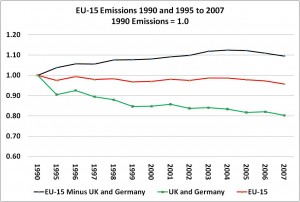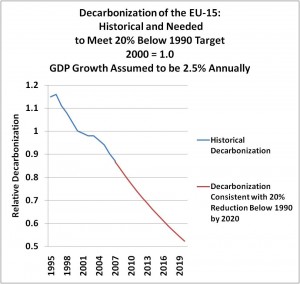Strong comments I know. Shoddy work on disasters and climate change is the norm, unfortunately, and something I’ve been closely following for well over a decade. I have no illusions that this latest concoction will be repeatedly cited regardless.
Below are my comments to the NYT upon reading the report (cleaned up and formatted). Caution, strong views ahead.
Let me apologize for the length of this reply. But it is important to be clear and to set the record straight.
Let me say first that human-caused climate change is an important problem requiring our utmost attention. Second, the effects of disasters, particularly in poorer countries, is also an important problem that to some degree has been overlooked, as I have argued for many years.
However, I cannot express how strongly I feel that this report has done a disservice to both issues. It is a methodological embarrassment and poster child for how to lie with statistics. The report will harm the cause for action on both climate change and disasters because it is so deeply flawed.
It will give ammunition to those opposed to action and divert attention away from the people who actually need help in the face of disasters, yet through this report have been reduced to a bloodless statistic for use in the promotional battle over climate policies. The report is worse than fiction, it is a lie. These are strong words I know.
1. Let me first start by noting that the same group that did the analysis for the UN, the Geo-Risks group in Munich Re, earlier this year published a peer-reviewed paper arguing that the signal of human-caused climate change could not presently be seen in the loss data on disasters. They wrote (emphasis added):
It should be noted when assessing the results of both this paper and Schmidt et al. (2008) that it is generally difficult to obtain valid quantitative findings about the role of socioeconomics and climate change in loss increases. This is because of criteria such as the stochastic nature of weather extremes, a shortage of quality data, and the role of various other potential factors that act in parallel and interact. We therefore regard our results as being an indication only of the extent to which socio-economic and climate changes account for the increase in losses. Both studies confirm the consensus reached in May 2006 at the international workshop in Hohenkammer attended by leading experts on climate change and natural catastrophe losses.
I co-organized the Hohenkammer workshop (referred to in the quote above) with Peter Hoeppe of Munich Re and that workshop concluded (among other things):
Due to data-quality issues, the stochastic nature of extreme event impacts, the lengths of the time series, and various societal factors present in the disaster loss records, it is still not possible to determine what portion of the increase in damage may be due to climate changes caused by GHG emissions.
and
The quantitative link (attribution) between storm/flood loss trends and GHG-induced climate changes is unlikely to be determined unequivocally in the near future.
On p. 84 the GHF report itself says:
However, there is not yet any widely accepted global estimate of the share of weather related disasters that are attributable to climate change.
One would think that would be the end of the story. However, to fill in for the fact that there is no accepted estimate, the report conjures up a number using an approach that is grounded in neither logic, science, or common sense.
2. Specifically, to get around the fact that there has been no attribution of the relationship of GHG emissions and disasters, this report engages in a very strange comparison of earthquake and weather disasters in 1980 and 2005. The first question that comes to mind is, why? They are comparing phenomena with many “moving parts” over a short time frame, and attributing 100% of the resulting difference to human-caused climate change. This boggles the mind. The IPCC itself says that 30 years are needed for the detection of changes in the climate system, and this time frame does not even reach that threshold. More to the point earthquakes and weather events do not have the same variability and earthquake disasters affect only a small part of the total inhabited area of the earth, whereas weather disasters occur much more widely. The assumption that weather disasters should track earthquake disasters is flawed from the outset for both geophysical and socio-economic reasons.
An alternative, more scientifically robust approach would be to look specifically at weather-related disasters, and consider the role of socio-economic changes, and to the extent possible, try to remove that signal and see what trends remain. When that has been done, in every case (US floods, hurricanes, Australia, India TCs, Latin America and elsewhere, all in the peer-reviewed literature) there is not a remaining signal of increasing disasters. In other words, the increase in disasters observed worldwide can be entirely attributed to socio-economic changes. This is what has been extensively documented in the peer reviewed literature, and yet — none of this literature is cited in this report. None of it! Instead they rely on this cooked up comparison between earthquakes and weather related disasters.
(Consider also that in no continental location has there been an observed increase in tropical cyclone landfalls, and yet this accounts for almost all of the windstorm disasters cited in the report. The increase must therefore be due to factors other than geophysical changes. This fact renders the
comparison with earthquakes even more meaningless).
Munich Re’s own peer-reviewed work supports the fact that socio-economic factors can explain the entire increase in global disasters in recent decades.
Consider that in 2005 there were 11 earthquakes magnitude 7 or higher and in 1980 there were 14. by contrast, 1980 was a quiet weather year, and 2005 was very active, and included Katrina.
Source
3. The report cites and undates the Stern Review Report estimates of disaster losses, however, in a peer-reviewed paper I showed that these estimates were off by an order of magnitude and relied on a similar sort of statistical gamesmanship to develop its results (and of course this critique was ignored):
Pielke, Jr., R. A., 2007. Mistreatment of the economic impacts of extreme events in the Stern Review Report on the Economics of Climate Change, Global Environmental Change, 17:302-310. (PDF)
This report is an embarrassment to the GHF and to those who have put their names on it as representing a scientifically robust analysis. It is not even close.
Best regards,
Roger

